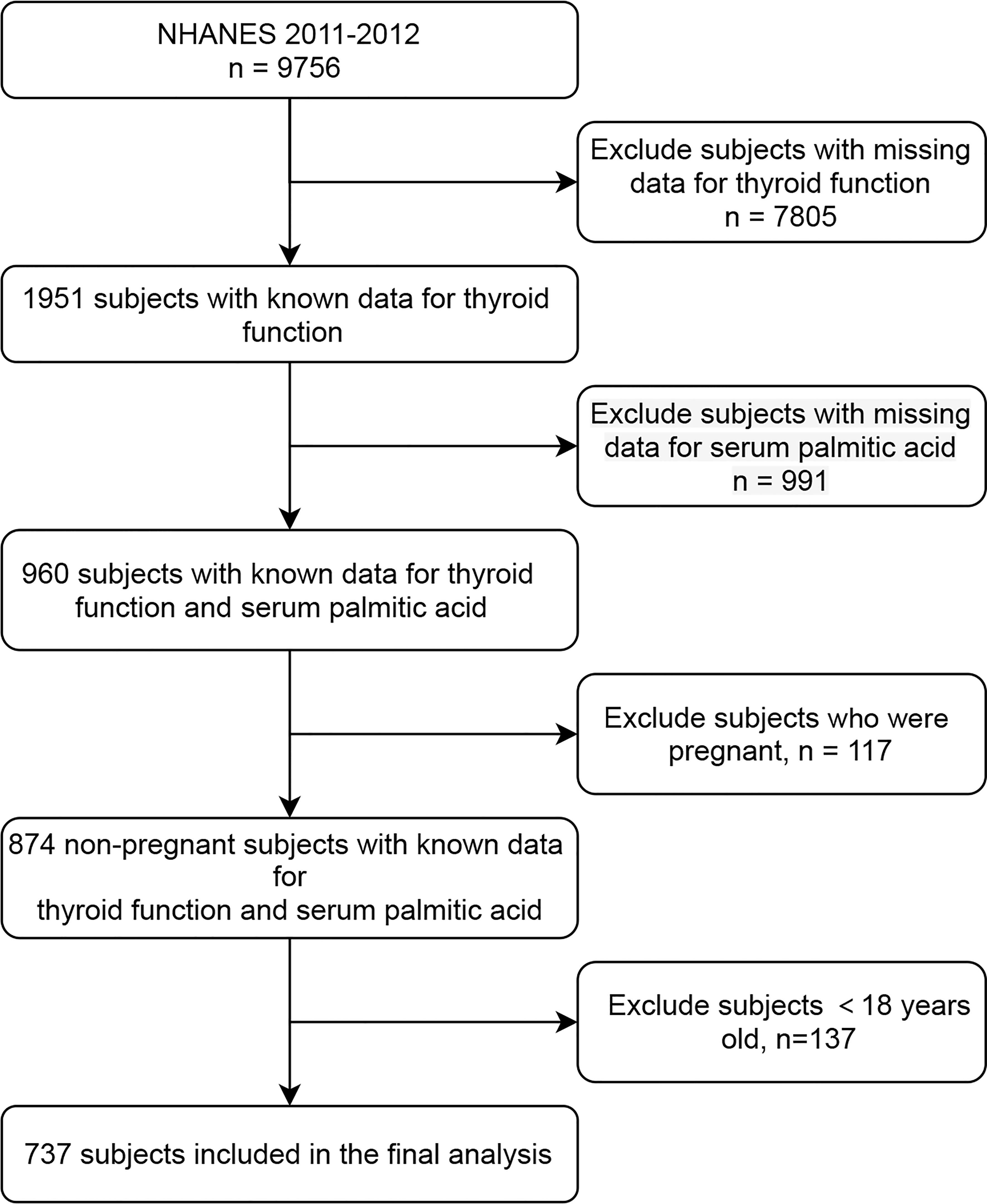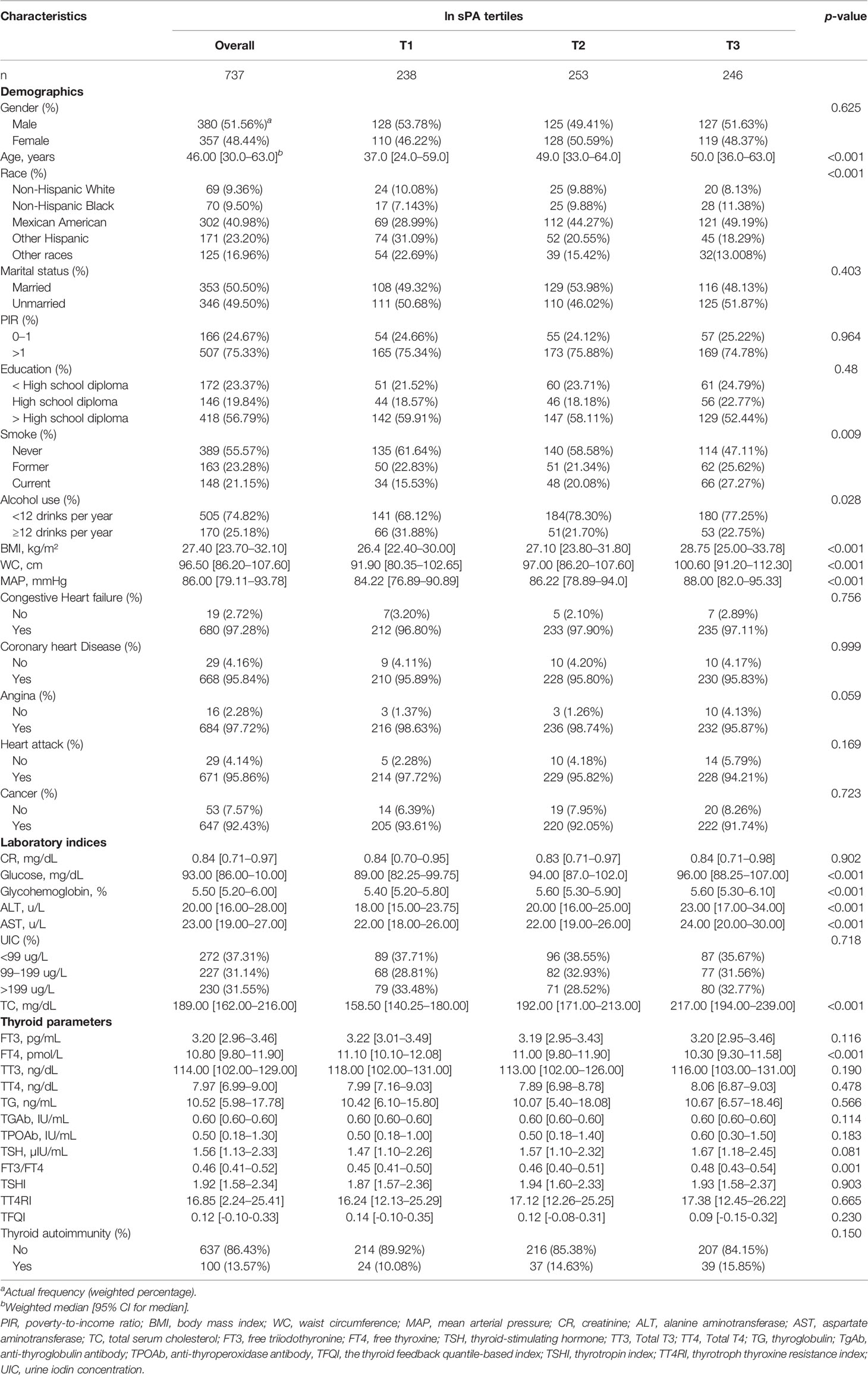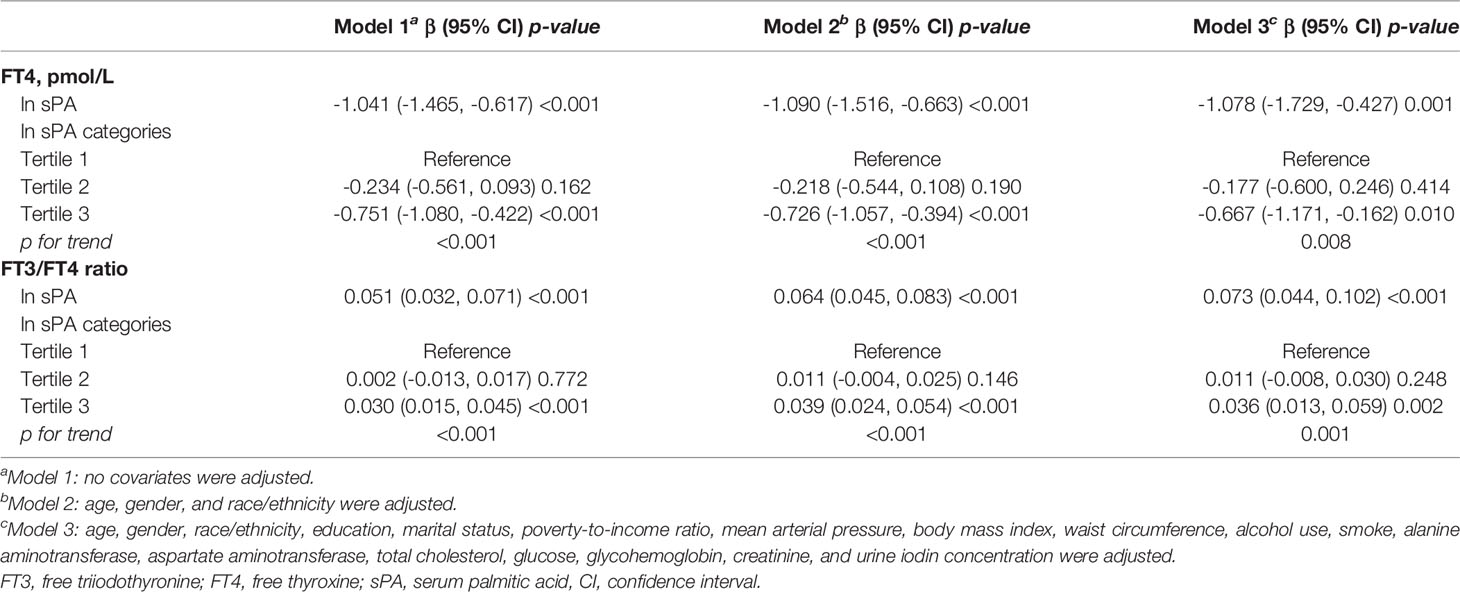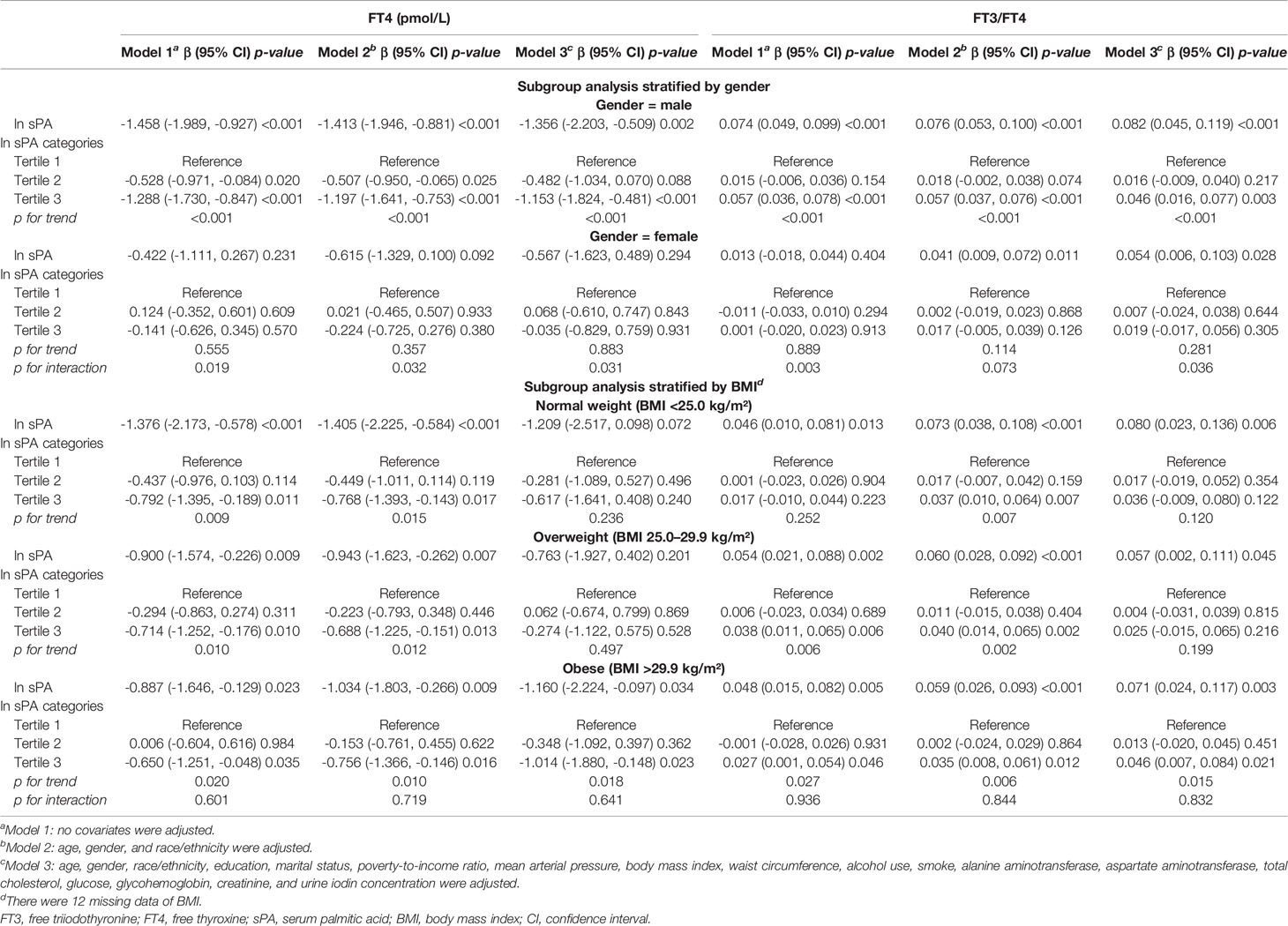- 1Department of General Surgery, Jiangsu Province Hospital of Chinese Medicine, Affiliated Hospital of Nanjing University of Chinese Medicine, Nanjing, China
- 2Department of Colorectal Surgery, Jiangsu Province Hospital of Chinese Medicine, Affiliated Hospital of Nanjing University of Chinese Medicine, Nanjing, China
Aim: Emerging evidence indicates that palmitic acid (PA) can regulate the progression and development of many diseases. However, the studies examining the association between PA and thyroid function remain sparse. We aimed to investigate the association between serum PA (sPA) and thyroid function in the US population.
Methods: In this retrospective study, a cross-sectional analysis was performed using the data pooled from the database of the National Health and Nutrition Examination Survey (NHANES) from 2011 to 2012. The thyroid parameters investigated were mainly free triiodothyronine (FT3), free thyroxine (FT4), total T3 (TT3), TT4, thyroglobulin (Tg), thyroid-stimulating hormone (TSH), anti-thyroglobulin antibody (TgAb), and anti-thyroperoxidase antibody (TPOAb). The central sensitivity to thyroid function was evaluated by the thyroid feedback quantile-based index (TFQI), thyrotrophin thyroxine resistance index (TT4RI), and thyrotropin index (TSHI). The FT3 to FT4 ratio (FT3/FT4) was employed to evaluate peripheral sensitivity to thyroid hormones. Multiple imputation was applied to handle the missing data, and weighted multivariable linear regression, subgroup, and interaction analyses were then employed to estimate the association between sPA and thyroid parameters.
Results: In the 737 adults, after adjusting covariates, we demonstrated a significant negative association between sPA and FT4 [β = -1.078, 95% confidence interval (CI): -1.729 to -0.427], as well as a positive relationship between sPA and FT3/FT4 ratio (β = 0.073, 95% CI: 0.044 to 0.102). These results did not change on multiple imputations. In the subgroup analyses, the associations were more significant in male and obese subjects.
Conclusion: This investigation demonstrated the significant correlation between sPA and thyroid dysfunction, which suggested the close relationship between lipotoxicity and hypothyroidism or subclinical hypothyroidism. Future research is required to confirm these findings.
Introduction
Palmitic acid (C16:0, PA) is the principal saturated fatty acid (SFA) of palm oil (PO) (1) and is also the most common plasma fatty acid (FA) in the human body (2, 3), representing 28%–32% of the total FAs in serum (4, 5). With increasing concerns about the relationship between nutrition and human health (6), there is growing evidence demonstrating that PA is much more than an energy source. The normal PA concentration is the basic guarantee for the multiple fundamental biological functions (3), whereas the overaccumulation of PA may result in adverse effects on human health (4). Emerging studies have linked elevated PA to multiple diseases (4), including cancers (7–10), diabetes (2, 11), metabolic syndrome (5, 12), cardiovascular diseases (CVDs) (13), autoimmune diseases (14), and neurodegenerative diseases (15, 16).
As is well known, thyroid hormones play a crucial role in regulating energy metabolism and cellular function (17). On the other hand, it is widely believed that lipotoxicity may lead to chronic cellular dysfunction and injury, with the thyroid gland considered to be the victim (18, 19). In a study by Araujo et al. (20), a high-fat diet could contribute to elevated serum thyroid-stimulating hormone (TSH) levels and increased systemic oxygen consumption. Shao et al. (21) reported that, in parallel with increased TSH levels, excess dietary high-fat lard intake could also induce decreased serum-free thyroxine (FT4) and total T4 (TT4) levels, as well as abnormal morphology in rats, which might be a long-term course. In addition, lipotoxicity was also correlated with the risk of subclinical hypothyroidism (SCH) (22). Furthermore, Zhao et al. (23) indicated that PA could downregulate the expressions and activity of the key molecules of thyroid hormone synthesis, including thyroglobulin (Tg), sodium iodide symporter (NIS), and thyroperoxidase (TPO). Moreover, lipotoxicity was also reported to be a significant risk factor in predicting extrathyroidal extension (ETE) of papillary thyroid microcarcinoma (PTMC) (24).
Although the excess intake of dietary fat is closely related to adverse health events, research investigating the association between serum PA (sPA) and thyroid function remains sparse. The current study aimed to examine the cross-sectional association between PA and thyroid parameters in a nationally representative sample of adults from the United States (US) using the National Health and Nutrition Examination Survey (NHANES) from 2011 to 2012.
Materials and Methods
Study Sample
NHANES is an ongoing cross-sectional survey conducted by the US Centers for Disease Control and Prevention, to assess the nutrition and health conditions of non-institutionalized citizens in the USA. The survey is performed biennially with a complex multistage cluster design, and the main sections of the database include demographics, dietary data, physical examinations, laboratory components, and multiple questionnaires. Before initiating interviews and data collection, the research protocol of NHANES has been approved by the Institutional Review Board (IRB) of the National Center for Health Statistics (NCHS), with written informed consent obtained.
The variables examined in the present study were pooled from NHANES 2011-2012 (‘‘G’’ data), since this cycle recorded full information on thyroid parameters and serum-free FAs. The participants who were not pregnant, aged 18 years or older, and had sPA, as well as thyroid function laboratory data, were included (Figure 1). The data were available on the NHANES website (https://www.cdc.gov/nchs/nhanes/).
Measurement of Serum PA
The detailed method of measuring serum-free fatty acids, including serum PA, is described in previous articles (25, 26) and the Laboratory Method Files section of NHANES. In the current study, the natural logarithm (ln) transformation was applied to the sPA data (ranging from 1,220 to 13,200 µmol/l), which was then investigated as a continuous and categorical variable in tertiles (T1 = 7.11–7.76, T2 = 7.77–8.01, T3 = 8.02–9.49).
Measurement of Thyroid Outcomes
The thyroid function parameters investigated in the present study included free triiodothyronine (FT3), FT4, TSH, total T3 (TT3), TT4, Tg, anti-thyroglobulin antibody (TgAb), and anti-thyroperoxidase antibody (TPOAb). The detailed specimen collection and processing instructions are available in the NHANES Laboratory/Medical Technologists Procedures Manual (LPM) and have been described in detail in the previous studies (27).
In the current work, the FT3/FT4 ratio was applied to reflect the converting activity of peripheral T4 to T3 (28). As for the central sensitivity to thyroid hormones, three indices were evaluated, including thyrotropin index (TSHI), thyrotrophin thyroxine resistance index (TT4RI), and thyroid feedback quantile-based index (TFQI). TSHI = ln TSH (mIU/L) + 0.1345 × FT4 (pmol/L) (29). TT4RI = FT4 (pmol/L) × TSH (mIU/L) (30). After transforming FT4 and TSH into quantiles between 0 and 1 by empirical cumulative distribution function (cdf), TFQI was then calculated according to the equation reported by Laclaustra et al. (31): TFQI = cdf FT4 (pmol/L) + cdf TSH (mIU/L)-1. Furthermore, thyroid autoimmunity was defined as TPOAb titers >9.0 IU/ml and/or TgAb titers >4.0 IU/ml (32). In addition, the urine iodine concentration (UIC) was employed to assess iodine conditions in participants, which was categorized into three groups: <99 µg/l, 99–199 µg/l, and >199 µg/l (33).
Measurement of Covariates
The demographic values of age, gender, race/ethnicity, education, marital status, poverty-to-income ratio (PIR), medical history [including congestive heart failure, coronary heart disease, angina pectoris, heart attack, and cancer (25)], and tobacco and alcohol consumption were obtained from self-reported data using a standardized questionnaire. Education level was coded into three groups as less than high school, high school diploma, and more than high school, and PIR was categorized as 0–1 and >1 to assess the socioeconomic status (SES) of the participants. As proposed by NHANES, tobacco use was coded as never, former, and current status. In addition, alcohol use was assessed by asking the question “Had at least 12 alcohol drinks/1 year?”.
The physical examination information regarding mean arterial pressure (MAP) and body mass index (BMI) was acquired in the Mobile Examination Centers (MECs) by certified technicians, which were calculated by using the following formula: (1) MAP = [(diastolic blood pressure × 2) + systolic blood pressure]/3; (2) BMI = body weight (kg)/height2 (m2). In addition, BMI was coded into three groups: normal (BMI <25.0 kg/m²), overweight (25.0 kg/m²≤ BMI ≤29.9 kg/m²), and obese (BMI >29.9 kg/m²) (27).
Furthermore, the laboratory indices examined in the present study included aspartate aminotransferase (AST, U/L), alanine aminotransferase (ALT, U/L), creatinine (mg/dL), serum glucose (mg/dL), glycohemoglobin (%), and total cholesterol (TC, mg/dL), which were recorded by practiced technicians using standardized laboratory methods.
Statistical Analysis
Since all of the continuous variables included in this work were abnormally distributed as evaluated by the Kolmogorov–Smirnov test, we applied the weighted Kruskal–Wallis (KW) test for the comparison of continuous variables to measure differences among ln sPA tertiles, which was presented as means and medians [interquartile ranges (IQRs)], while categorical variables were assessed by weighted chi-square test and were summarized using frequency counts and weighted percentages. Weighted multivariable linear and logistic regressions were then employed to investigate the association between ln sPA and thyroid function, including free and total T4 and T3, TSH, Tg, TgAb, TPOAb, thyroid autoimmunity, TFQI, TSHI, TT4RI, and FT3/FT4 ratio. Furthermore, to impute missing data, we employed multivariate multiple imputations with 5 replications and a chained equation approach (34). Interaction and stratified analyses were then conducted according to gender and BMI category. In addition, for addressing the non-linear relationship, smooth curve fittings and generalized additive models were employed. All data analyses were performed using the statistical software packages R 4.1.0 (http://www.R-project.org) and EmpowerStats (http://www.empowerstats.com, X&Y Solutions, Inc., Boston, MA), with a two-tailed p value <0.05 considered statistically significant.
Results
Baseline Characteristics of Participants
The study included 737 participants (range: 18–80 years) from NHANES 2011–2012, among which 380 were men and 357 were women. As demonstrated on Table 1, among sPA tertiles, the statistically significant (p < 0.05) thyroid parameters included FT4 and the FT3/FT4 ratio, which among all subjects were 10.80 (IQR: 9.80–11.90) pmol/l and 0.46 (IQR: 0.41–0.52), respectively. For covariates, the differences with statistical significance (p < 0.05) were age (p < 0.001), race/ethnicity (p < 0.001), smoking status (p = 0.009), alcohol use (p = 0.028), BMI (p < 0.001), waist circumference (p < 0.001), MAP (p < 0.001), AST (p < 0.001), ALT (p < 0.001), serum glucose (p < 0.001), glycohemoglobin (p < 0.001), and TC (p < 0.001). As shown in Supplementary Table S1, there were no statistical differences among covariates in 5 replications.
Association Between sPA and Thyroid Parameters
As demonstrated in Table 2, Figure 2, and Supplementary Table S2, sPA was significantly negatively and positively correlated with FT4 and the FT3/FT4 ratio, respectively, while the association between sPA and other thyroid parameters is listed in Supplementary Table S3. As shown in Table 2, the negative association between sPA and FT4 was present in the unadjusted model [β = -1.041, 95% confidence interval (CI): -1.465 to -0.617, p < 0.001], model 2 (β = -1.090, 95% CI: -1.516 to -0.663, p < 0.001), and model 3 (β = -1.078, 95% CI: -1.729 to -0.427, p = 0.001). Similarly, Table 2 indicates a significant positive relationship between sPA and the FT3/FT4 ratio in the unadjusted model (β = 0.051, 95% CI: 0.032 to 0.071, p < 0.001), which existed after adjusting covariates, as indicated in model 2 (β = 0.064, 95% CI: 0.045 to 0.083, p < 0.001) and model 3 (β = 0.073, 95% CI: 0.044 to 0.102, p < 0.001). The significant relationship was also presented after categorizing ln sPA into tertiles (p for trend < 0.05), and the participants in the highest sPA tertile had a 0.667-pmol/l lower FT4 than those in the lowest sPA tertile (p = 0.009) in model 3, who also had a 0.036 greater FT3/FT4 ratio (p = 0.002).
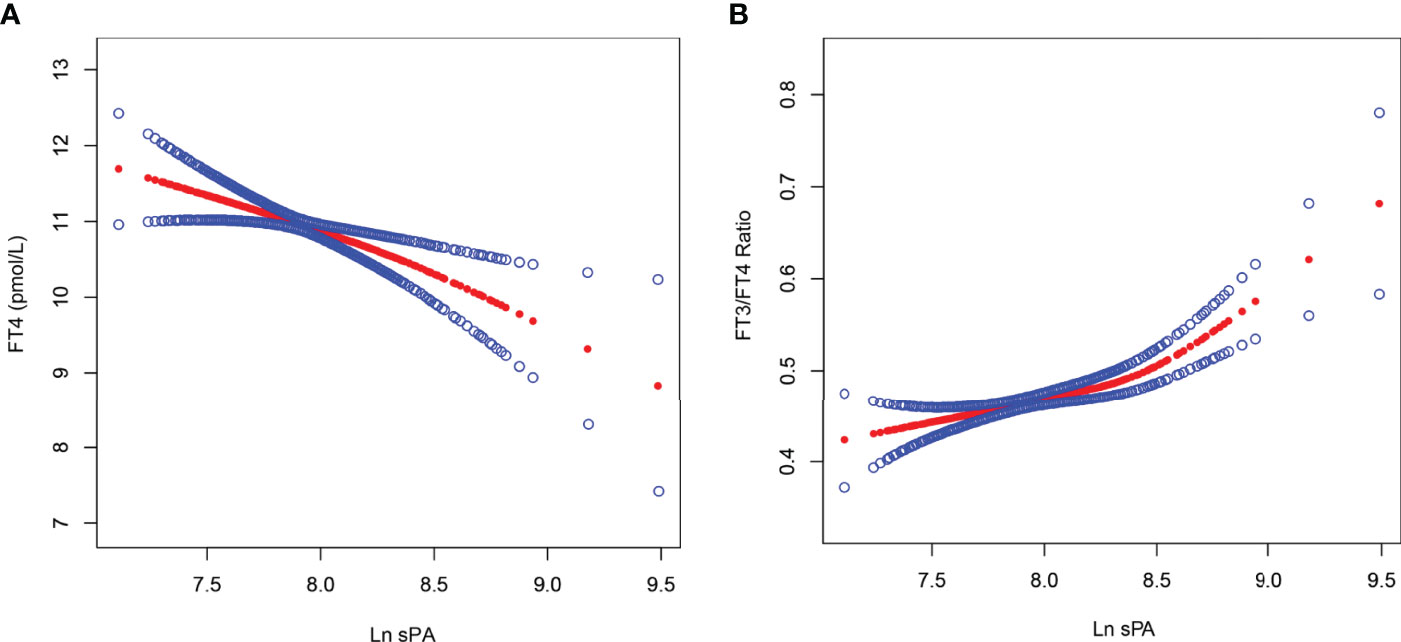
Figure 2 The association between ln sPA and FT4, as well as FT3/FT4 ratio. Solid red line represents the smooth curve fit between ln sPA and FT4 (A), as well as FT3/FT4 ratio (B). Blue bands represent the 95% of confidence interval from the fit. Age, gender, race/ethnicity, education, marital status, poverty-to-income ratio, mean arterial pressure, body mass index, waist circumference, alcohol use, smoke, alanine aminotransferase, aspartate aminotransferase, total cholesterol, glucose, glycohemoglobin, creatinine, and urine iodin concentration were adjusted. FT3, free triiodothyronine; FT4, free thyroxine; sPA, serum palmitic acid.
Furthermore, the subgroup analysis indicated that gender was the interactive factor in the correlation between sPA and FT4 (p for interaction = 0.031), as well as the FT3/FT4 ratio (p for interaction = 0.036). As shown in Table 3, the association between sPA and FT4 was more significant in the male (β = -1.356, 95% CI: -2.203 to -0.509, p = 0.002, p for trend < 0.001) and obese (β = -1.160, 95% CI: -2.224 to -0.097, p = 0.034, p for trend = 0.018) participants in model 3; similar results were found in the relationship between sPA and the FT3/FT4 ratio, as the effect size was 0.082 for male (β = 0.082, 95% CI: 0.045 to 0.119, p <0.001, p for trend <0.001) and 0.071 for obese adults (β = 0.071, 95% CI: 0.024 to 0.117, p = 0.003, p for trend = 0.015).
Discussion
The present retrospective investigation aimed to assess the relationship between sPA and thyroid function in a nationally representative sample of the population in the USA. In the 737 adult participants (age ≥18), we noted a significant association between sPA and FT4, and the FT3/FT4 ratio throughout multiple analyses. Subgroup analysis stratified by gender and BMI category indicated that the FT4 level and the FT3/FT4 ratio decreased and increased prominently in male and obese participants with higher sPA, respectively. Furthermore, interaction terms suggested that gender might influence the aforementioned associations.
In recent years, there has been an emerging focus on the effect of a high-fat diet (HFD) on human diseases, which could promote the disorders of lipid metabolism and triglyceride accumulation in non-adipose tissues (7, 35). In addition, increasing evidence has demonstrated the close relationship between lipid metabolism disorder and thyroid dysfunction, especially hypothyroidism or SCH (7, 35). In a cohort of 24,100 Chinese subjects with similar and stable iodine nutrition status, Zhao et al. (22) illustrated the significant positive association between the elevation of serum triglyceride levels and the risk for SCH. Similarly, Lai et al. (36) and Kota et al. (37) observed higher TSH levels in the participants with hypertriglyceridemia, which further suggested that the thyroid gland might be the victim of lipotoxicity. Primary thyroid hypofunction was also reported in diet-induced obese (DIO) mice, as well as the increased expression levels of the key molecules in the thyroid gland such as the TSH receptor, TPO, NIS, and Tg (38). However, in the experiments about the effect of short-term and long-term HFD feeding on obesity-prone (OP) and obesity-resistant (OR) mice, Xia et al. (39) illustrated suppressed NIS, TPO, and Tg mRNA levels in OP mice, and contradictory observations might be speculated to the upregulated TSH level (23). As shown in Table 1, this work also observed a slightly increased TSH level within the normal range in elevated ln sPA tertile; however, the statistical difference was insignificant (p = 0.081). On the other hand, the significant negative association between sPA and FT4 was considered to support the close correlation between lipotoxicity and hypothyroidism or SCH, and the hypothesis is desired in future studies.
As a representative SFA, PA has been widely applied in experiments investigating the underlying mechanisms of lipotoxicity on cellular damage (40). The present work showed that the elevated sPA level was significantly related to decreased FT4 (p < 0.001) and increased FT3/FT4 ratio (p = 0.001) after adjusting covariates, and the potential mechanism could be elucidated in some other studies. For instance, in human thyrocytes, Zhao et al. (23) demonstrated that PA could suppress NIS, TPO, and Tg mRNA levels, as well as promote intracellular lipid accumulation. Several studies have illustrated that endoplasmic reticulum (ER) stress could inhibit the expression of the three key molecules and their regulators in the thyrocytes (41, 42). In addition, ER stress was also observed in HFD rats and PA-treated thyrocytes, along with the increased degradation rate of Tg, which further indicated that the effect of ER stress on HFD-induced hypothyroidism might contribute to a decrease in the production of Tg (35).
As demonstrated in Tables 1, 3, the subjects with elevated sPA level were more likely to have larger BMI and waist circumference, and the relationship between sPA and thyroid dysfunction was more significant in obese and male participants; several investigations might provide some implications to the underlying mechanism. As is well known, obesity results from an imbalance between caloric intake and caloric expenditure (43), and thyroid hormones (THs) play a pivotal role in modulating the energy balance, appetite, basal metabolic rate (BMR), and lipid metabolism (44). Changes in THs in obese subjects have been reported in various epidemiological studies, and Walczak et al. (44) further observe that obesity through lipotoxicity may lead to thyroid dysfunction and promote the development of SCH. Moreover, in the contralateral lobe of thyroid tissue derived from patients with PTMC, Lee et al. (38) observed the expansion of interfollicular adipose (IFA) depot and steatosis in thyroid follicular cells (thyroid steatosis, TS) in the majority of obese patients (BMI ≥25.0 kg/m²). Furthermore, SCH and morphological changes in the thyroid tissue were also documented in the male obese mice, which could not be remitted by peroxisome proliferator-activated receptor γ (PPARγ) agonist administration (38).
The findings of the present work should be interpreted cautiously because of some limitations. First, for the cross-sectional design of NHANES, the causal relationships between sPA and thyroid parameters could not be established. Hence, a cohort study with long observation periods and a larger sample size is desired in the future study. Second, the information on medical history, SES, marital status, tobacco consumption, and alcohol use was self-reported data obtained from questionnaires; thus, recall bias and several other errors could not be ruled out. Subsequently, we excluded children and pregnant participants on account of the uncertain influence on thyroid function, and further research is needed on these populations.
Conclusion
In conclusion, we demonstrated the significant negative and positive relationship between sPA and FT4, and the FT3/FT4 ratio, respectively, in a representative population in the US. These results did not change on multiple imputations. In the subgroup analyses, the aforementioned associations were more remarkable in male and obese subjects. Our findings supported the close relationship between lipotoxicity and hypothyroidism or SCH, and further studies are needed to confirm this deduction. In addition, further studies are needed to verify the causal association between PA and thyroid function.
Data Availability Statement
The original contributions presented in the study are included in the article/Supplementary Material. Further inquiries can be directed to the corresponding authors.
Author Contributions
All authors listed have made a substantial, direct, and intellectual contribution to the work, and approved it for publication.
Funding
This work was supported by grants from the Natural Science Foundation of Jiangsu Province (BK20181506) and Project of Jiangsu Province Hospital of Chinese Medicine (Y21024).
Conflict of Interest
The authors declare that the research was conducted in the absence of any commercial or financial relationships that could be construed as a potential conflict of interest.
Publisher’s Note
All claims expressed in this article are solely those of the authors and do not necessarily represent those of their affiliated organizations, or those of the publisher, the editors and the reviewers. Any product that may be evaluated in this article, or claim that may be made by its manufacturer, is not guaranteed or endorsed by the publisher.
Acknowledgments
We thank the participants and staff of NHANES.
Supplementary Material
The Supplementary Material for this article can be found online at: https://www.frontiersin.org/articles/10.3389/fendo.2022.860634/full#supplementary-material
References
1. Mancini A, Imperlini E, Nigro E, Montagnese C, Daniele A, Orru S, et al. Biological and Nutritional Properties of Palm Oil and Palmitic Acid: Effects on Health. Molecules (2015) 20(9):17339–61. doi: 10.3390/molecules200917339
2. Palomer X, Pizarro-Delgado J, Barroso E, Vazquez-Carrera M. Palmitic and Oleic Acid: The Yin and Yang of Fatty Acids in Type 2 Diabetes Mellitus. Trends Endocrinol Metab (2018) 29(3):178–90. doi: 10.1016/j.tem.2017.11.009
3. Carta G, Murru E, Banni S, Manca C. Palmitic Acid: Physiological Role, Metabolism and Nutritional Implications. Front Physiol (2017) 8:902. doi: 10.3389/fphys.2017.00902
4. Fatima S, Hu X, Gong RH, Huang C, Chen M, Wong H, et al. Palmitic Acid is an Intracellular Signaling Molecule Involved in Disease Development. Cell Mol Life Sci (2019) 76(13):2547–57. doi: 10.1007/s00018-019-03092-7
5. Yu Y, Cai Z, Zheng J, Chen J, Zhang X, Huang XF, et al. Serum Levels of Polyunsaturated Fatty Acids are Low in Chinese Men With Metabolic Syndrome, Whereas Serum Levels of Saturated Fatty Acids, Zinc, and Magnesium are High. Nutr Res (2012) 32(2):71–7. doi: 10.1016/j.nutres.2011.12.004
6. Cao Y, Chen J, Ren G, Zhang Y, Tan X, Yang L. Punicalagin Prevents Inflammation in LPS-Induced RAW264.7 Macrophages by Inhibiting FoxO3a/Autophagy Signaling Pathway. Nutrients (2019) 11(11):2794. doi: 10.3390/nu11112794
7. Pascual G, Dominguez D, Elosua-Bayes M, Beckedorff F, Laudanna C, Bigas C, et al. Dietary Palmitic Acid Promotes a Prometastatic Memory via Schwann Cells. Nature (2021) 599(7885):485–90. doi: 10.1038/s41586-021-04075-0
8. Kwan HY, Fu X, Liu B, Chao X, Chan CL, Cao H, et al. Subcutaneous Adipocytes Promote Melanoma Cell Growth by Activating the Akt Signaling Pathway: Role of Palmitic Acid. J Biol Chem (2014) 289(44):30525–37. doi: 10.1074/jbc.M114.593210
9. Rohrig F, Schulze A. The Multifaceted Roles of Fatty Acid Synthesis in Cancer. Nat Rev Cancer (2016) 16(11):732–49. doi: 10.1038/nrc.2016.89
10. Lin L, Ding Y, Wang Y, Wang Z, Yin X, Yan G, et al. Functional Lipidomics: Palmitic Acid Impairs Hepatocellular Carcinoma Development by Modulating Membrane Fluidity and Glucose Metabolism. Hepatology (2017) 66(2):432–48. doi: 10.1002/hep.29033
11. Hilvo M, Salonurmi T, Havulinna AS, Kauhanen D, Pedersen ER, Tell GS, et al. Ceramide Stearic to Palmitic Acid Ratio Predicts Incident Diabetes. Diabetologia (2018) 61(6):1424–34. doi: 10.1007/s00125-018-4590-6
12. Kabagambe EK, Tsai MY, Hopkins PN, Ordovas JM, Peacock JM, Borecki IB, et al. Erythrocyte Fatty Acid Composition and the Metabolic Syndrome: A National Heart, Lung, and Blood Institute GOLDN Study. Clin Chem (2008) 54(1):154–62. doi: 10.1373/clinchem.2007.095059
13. Wang Y, Qian Y, Fang Q, Zhong P, Li W, Wang L, et al. Saturated Palmitic Acid Induces Myocardial Inflammatory Injuries Through Direct Binding to TLR4 Accessory Protein MD2. Nat Commun (2017) 8:13997. doi: 10.1038/ncomms13997
14. Tsoukalas D, Fragoulakis V, Sarandi E, Docea AO, Papakonstaninou E, Tsilimidos G, et al. Targeted Metabolomic Analysis of Serum Fatty Acids for the Prediction of Autoimmune Diseases. Front Mol Biosci (2019) 6:120. doi: 10.3389/fmolb.2019.00120
15. Marwarha G, Rostad S, Lilek J, Kleinjan M, Schommer J, Ghribi O. Palmitate Increases Beta-Site AbetaPP-Cleavage Enzyme 1 Activity and Amyloid-Beta Genesis by Evoking Endoplasmic Reticulum Stress and Subsequent C/EBP Homologous Protein Activation. J Alzheimers Dis (2017) 57(3):907–25. doi: 10.3233/JAD-161130
16. Patil S, Melrose J, Chan C. Involvement of Astroglial Ceramide in Palmitic Acid-Induced Alzheimer-Like Changes in Primary Neurons. Eur J Neurosci (2007) 26(8):2131–41. doi: 10.1111/j.1460-9568.2007.05797.x
17. van den Beld AW, Kaufman JM, Zillikens MC, Lamberts S, Egan JM, van der Lely AJ. The Physiology of Endocrine Systems With Ageing. Lancet Diabetes Endocrinol (2018) 6(8):647–58. doi: 10.1016/S2213-8587(18)30026-3
18. Gong Y, Yang J, Wei S, Yang R, Gao L, Shao S, et al. Lipotoxicity Suppresses the Synthesis of Growth Hormone in Pituitary Somatotrophs via Endoplasmic Reticulum Stress. J Cell Mol Med (2021) 25(11):5250–9. doi: 10.1111/jcmm.16532
19. Ren R, Ma Y, Deng F, Li T, Wang H, Wei J, et al. Association Between Serum TSH Levels and Metabolic Components in Euthyroid Subjects: A Nationwide Population-Based Study. Diabetes Metab Syndr Obes (2019) 12:1563–9. doi: 10.2147/DMSO.S202769
20. Araujo RL, Andrade BM, Padron AS, Gaidhu MP, Perry RL, Carvalho DP, et al. High-Fat Diet Increases Thyrotropin and Oxygen Consumption Without Altering Circulating 3,5,3'-Triiodothyronine (T3) and Thyroxine in Rats: The Role of Iodothyronine Deiodinases, Reverse T3 Production, and Whole-Body Fat Oxidation. Endocrinology (2010) 151(7):3460–9. doi: 10.1210/en.2010-0026
21. Shao SS, Zhao YF, Song YF, Xu C, Yang JM, Xuan SM, et al. Dietary High-Fat Lard Intake Induces Thyroid Dysfunction and Abnormal Morphology In Rats. Acta Pharmacol Sin (2014) 35(11):1411–20. doi: 10.1038/aps.2014.82
22. Zhao M, Tang X, Yang T, Zhang B, Guan Q, Shao S, et al. Lipotoxicity, a Potential Risk Factor for the Increasing Prevalence of Subclinical Hypothyroidism? J Clin Endocrinol Metab (2015) 100(5):1887–94. doi: 10.1210/jc.2014-3987
23. Zhao M, Zhang X, Gao L, Song Y, Xu C, Yu C, et al. Palmitic Acid Downregulates Thyroglobulin (Tg), Sodium Iodide Symporter (NIS), and Thyroperoxidase (TPO) in Human Primary Thyrocytes: A Potential Mechanism by Which Lipotoxicity Affects Thyroid? Int J Endocrinol (2018) 2018:4215848. doi: 10.1155/2018/4215848
24. Li C, Guan H, He Q, Zhao Y, Liang N, Zhang J, et al. The Relationship Between Lipotoxicity and Risk of Extrathyroidal Extension in Papillary Thyroid Microcarcinoma. Endocrine (2021) 74(3):646–57. doi: 10.1007/s12020-021-02809-8
25. Kao CC, Yang ZY, Cheng YW, Chen WL. Examining the Association Between Serum Free Fatty Acids and Blood Levels of Testosterone. J Hum Nutr Diet (2021) 34(2):334–44. doi: 10.1111/jhn.12828
26. Lagerstedt SA, Hinrichs DR, Batt SM, Magera MJ, Rinaldo P, McConnell JP. Quantitative Determination of Plasma C8-C26 Total Fatty Acids for the Biochemical Diagnosis of Nutritional and Metabolic Disorders. Mol Genet Metab (2001) 73(1):38–45. doi: 10.1006/mgme.2001.3170
27. Liu N, Ma F, Feng Y, Ma X. The Association Between the Dietary Inflammatory Index and Thyroid Function in U.S. Adult Males. Nutrients (2021) 13(10):3330. doi: 10.3390/nu13103330
28. Nie X, Ma X, Xu Y, Shen Y, Wang Y, Bao Y. Increased Serum Adipocyte Fatty Acid-Binding Protein Levels Are Associated With Decreased Sensitivity to Thyroid Hormones in the Euthyroid Population. Thyroid (2020) 30(12):1718–23. doi: 10.1089/thy.2020.0011
29. Jostel A, Ryder WD, Shalet SM. The Use of Thyroid Function Tests in the Diagnosis of Hypopituitarism: Definition and Evaluation of the TSH Index. Clin Endocrinol (Oxf) (2009) 71(4):529–34. doi: 10.1111/j.1365-2265.2009.03534.x
30. Yagi H, Pohlenz J, Hayashi Y, Sakurai A, Refetoff S. Resistance to Thyroid Hormone Caused by Two Mutant Thyroid Hormone Receptors Beta, R243Q and R243W, With Marked Impairment of Function That Cannot Be Explained by Altered In Vitro 3,5,3'-Triiodothyroinine Binding Affinity. J Clin Endocrinol Metab (1997) 82(5):1608–14. doi: 10.1210/jcem.82.5.3945
31. Laclaustra M, Moreno-Franco B, Lou-Bonafonte JM, Mateo-Gallego R, Casasnovas JA, Guallar-Castillon P, et al. Impaired Sensitivity to Thyroid Hormones Is Associated With Diabetes and Metabolic Syndrome. Diabetes Care (2019) 42(2):303–10. doi: 10.2337/dc18-1410
32. Yehuda M, Wang CH, Pak Y, Chiu KC, Gianoukakis AG. Parity and Risk of Thyroid Autoimmunity Based on the NHANES (2001-2002, 2007-2008, 2009-2010, and 2011-2012). J Clin Endocrinol Metab (2017) 102(9):3437–42. doi: 10.1210/jc.2017-00290
33. Zimmermann MB, Boelaert K. Iodine Deficiency and Thyroid Disorders. Lancet Diabetes Endocrinol (2015) 3(4):286–95. doi: 10.1016/S2213-8587(14)70225-6
34. Park SY, Freedman ND, Haiman CA, Le Marchand L, Wilkens LR, Setiawan VW. Association of Coffee Consumption With Total and Cause-Specific Mortality Among Nonwhite Populations. Ann Intern Med (2017) 167(4):228–35. doi: 10.7326/M16-2472
35. Zhang X, Shao S, Zhao L, Yang R, Zhao M, Fang L, et al. ER Stress Contributes to High-Fat Diet-Induced Decrease of Thyroglobulin and Hypothyroidism. Am J Physiol Endocrinol Metab (2019) 316(3):E510–8. doi: 10.1152/ajpendo.00194.2018
36. Lai Y, Wang J, Jiang F, Wang B, Chen Y, Li M, et al. The Relationship Between Serum Thyrotropin and Components of Metabolic Syndrome. Endocr J (2011) 58(1):23–30. doi: 10.1507/endocrj.k10e-272
37. Kota SK, Meher LK, Krishna S, Modi K. Hypothyroidism in Metabolic Syndrome. Indian J Endocrinol Metab (2012) 16(Suppl 2):S332–3. doi: 10.4103/2230-8210.104079
38. Lee MH, Lee JU, Joung KH, Kim YK, Ryu MJ, Lee SE, et al. Thyroid Dysfunction Associated With Follicular Cell Steatosis in Obese Male Mice and Humans. Endocrinology (2015) 156(3):1181–93. doi: 10.1210/en.2014-1670
39. Xia SF, Duan XM, Hao LY, Li LT, Cheng XR, Xie ZX, et al. Role of Thyroid Hormone Homeostasis in Obesity-Prone and Obesity-Resistant Mice Fed a High-Fat Diet. Metabolism (2015) 64(5):566–79. doi: 10.1016/j.metabol.2014.12.010
40. Ohtsubo K, Chen MZ, Olefsky JM, Marth JD. Pathway to Diabetes Through Attenuation of Pancreatic Beta Cell Glycosylation and Glucose Transport. Nat Med (2011) 17(9):1067–75. doi: 10.1038/nm.2414
41. Wen G, Eder K, Ringseis R. Resveratrol Alleviates the Inhibitory Effect of Tunicamycin-Induced Endoplasmic Reticulum Stress on Expression of Genes Involved in Thyroid Hormone Synthesis in FRTL-5 Thyrocytes. Int J Mol Sci (2021) 22(9):4373. doi: 10.3390/ijms22094373
42. Wen G, Ringseis R, Eder K. Endoplasmic Reticulum Stress Inhibits Expression of Genes Involved in Thyroid Hormone Synthesis and Their Key Transcriptional Regulators in FRTL-5 Thyrocytes. PloS One (2017) 12(11):e0187561. doi: 10.1371/journal.pone.0187561
43. Cardoso S, Moreira PI. Diabesity and Brain Disturbances: A Metabolic Perspective. Mol Aspects Med (2019) 66:71–9. doi: 10.1016/j.mam.2018.10.002
Keywords: palmitic acid, thyroid function, cross-sectional analysis, free thyroxine, NHANES
Citation: Zhou G, Xu Y, Zhai Y, Gong Z, Xu K, Wang G, Sun C and Ma C (2022) The Association Between Serum Palmitic Acid and Thyroid Function. Front. Endocrinol. 13:860634. doi: 10.3389/fendo.2022.860634
Received: 27 January 2022; Accepted: 29 March 2022;
Published: 03 May 2022.
Edited by:
Rosalba Senese, University of Campania Luigi Vanvitelli, ItalyCopyright © 2022 Zhou, Xu, Zhai, Gong, Xu, Wang, Sun and Ma. This is an open-access article distributed under the terms of the Creative Commons Attribution License (CC BY). The use, distribution or reproduction in other forums is permitted, provided the original author(s) and the copyright owner(s) are credited and that the original publication in this journal is cited, in accordance with accepted academic practice. No use, distribution or reproduction is permitted which does not comply with these terms.
*Correspondence: Chenhua Sun, Y2hlbmh1YV9zdW5Abmp1Y20uZWR1LmNu; Chaoqun Ma, ZG9jdG9ybWFjaGFvcXVuQGdtYWlsLmNvbQ==
†These authors have contributed equally to this work
 Guowei Zhou
Guowei Zhou Yumeng Xu
Yumeng Xu Yuqing Zhai1†
Yuqing Zhai1†